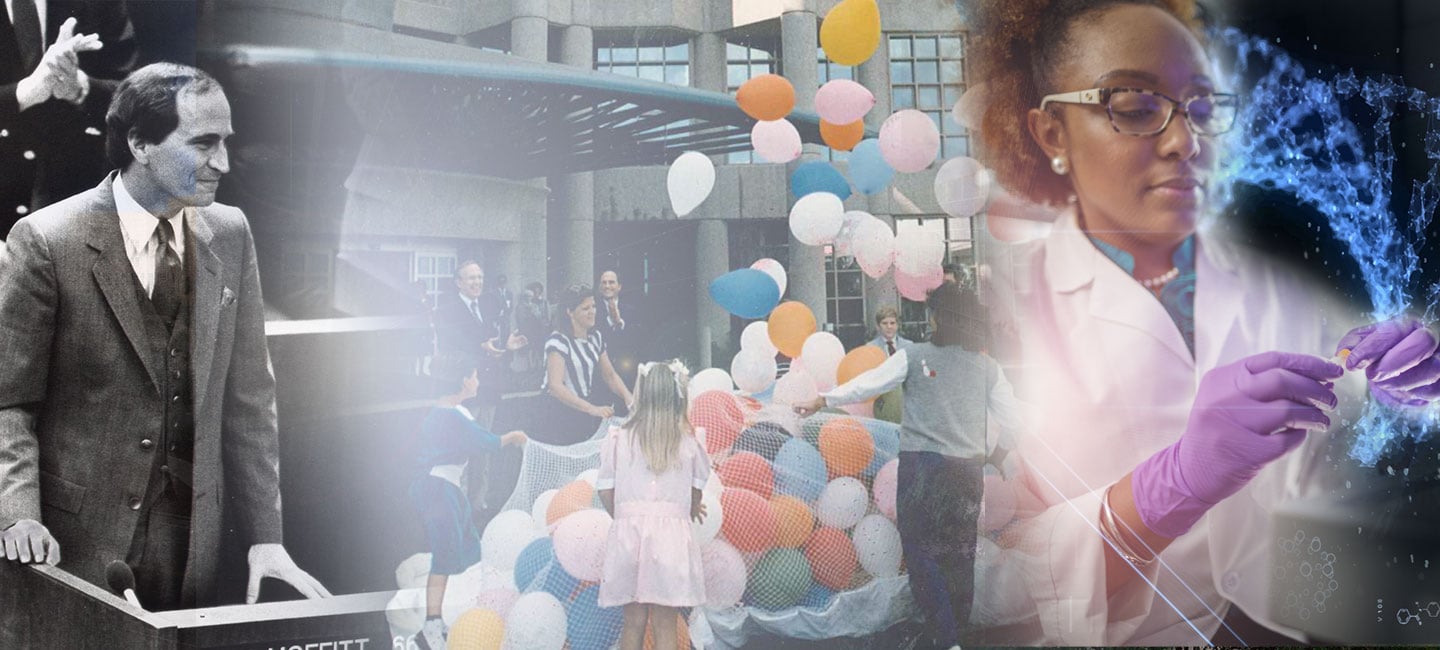Moffitt Celebrates 37th Anniversary
The first patients walked through the doors at Moffitt Cancer Center on Oct. 27, 1986. The cancer center is the brain child of Florida State Rep. H. Lee Moffitt, who dreamed of a specialized cancer center in Florida after three friends battling the disease had to go out of state for treatment.
Moffitt was able to push through the necessary legislation and secure funding for the cancer center with a small percentage of state cigarette tax revenue. His dream ultimately became a reality, and he celebrated the groundbreaking for the $70 million, 162-bed facility in 1983.
Over the next 37 years, Moffitt Cancer Center would experience incredible and unprecedented growth. The cancer center has expanded its physical presence across the state, added more than 7,000 team members and provided cutting-edge patient care. Despite all the changes, the cancer center has stayed true to its original mission: to contribute to the prevention and cure of cancer.
Here are the top 37 milestones over the past 37 years:
- 1981: Our history starts even before opening our doors as H. Lee Moffitt’s dream begins to take shape in June 1981 when the Florida Legislature passes a bill to create Moffitt Cancer Center in Tampa, Florida.
- 1983: Moffitt Cancer Center breaks ground and construction begins.
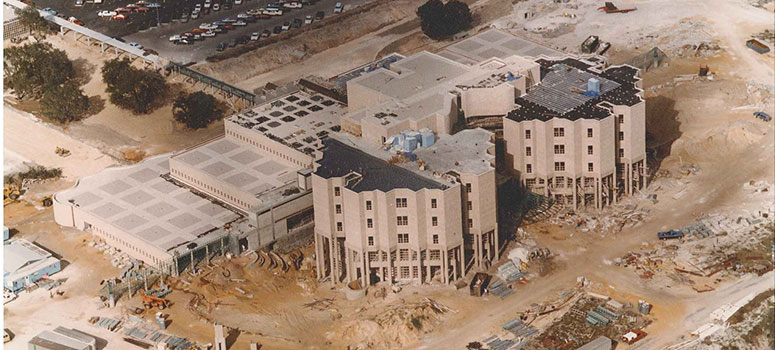
Moffitt breaks ground on the new hospital in 1983 and begins a three-year construction project.
- 1986: Moffitt Cancer Center opens on Oct. 27, 1986, as the first free standing cancer treatment and research center authorized by the state of Florida. There are 409 team members.
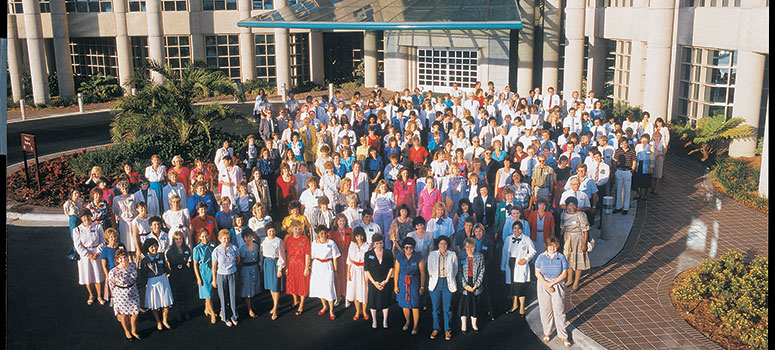
Moffitt employed 409 team members when it opened its doors in 1986. There are now more than 7,000.
- 1989: Blood and Marrow Transplant Program opens.
- 1992: The first scientist joins Moffitt and research recruitment began in earnest two years later.
- 1994: The Moffitt Cancer Center Foundation is formed to support cancer research, patient care and education initiatives.
- 1994: The first Magnolia Ball is held. The signature gala event has raised almost $50 million for cancer research over the years.

Guests enjoy themselves at the 2006 Magnolia Ball.
- 1995: The Moffitt Research Center opens.
- 1996: The Mole Patrol was established, hosting its first screening at Pier 60 on Clearwater Beach. Since then, the team has screened more than 18,000 people and found almost 14,000 suspicious lesions that required follow up.
- 1998: Moffitt receives National Cancer Institute designation and its first Cancer Center Support Grant.
- 1998: The Arts In Medicine Program is created to bring creative, empowering and meaningful experiences to patients and staff.

Guests enjoy crafting art at the Arts in Medicine Studio on the Magnolia Campus.
- 1999: Moffitt is ranked for the first time in U.S. News and World Report as one of the “Best Hospitals” for cancer and has appeared on the list ever since.
- 1999: The Ted Couch Cancer Research Lectureship is established to honor scientists who have made significant contributions to cancer research.
- 2001: Moffitt is named a Comprehensive Cancer Center by the National Cancer Institute just three years after it earned its NCI designation. Only 52 centers nationwide have met the rigorous standards for this designation, and Moffitt is still the only NCI Comprehensive Cancer Center based in Florida.
- 2003: A new outpatient clinic facility named the Muriel Rothman Building and the Vincent A. Stabile Research Building open on Moffitt’s Magnolia campus.
- 2003: The Total Cancer Care research initiative is established to help change the way doctors prevent, detect and treat cancer.
- 2003: After acknowledging a need to address health care disparities, establish community relationships and improve patient care for all, Moffitt creates the Office of Institutional Diversity.
- 2006: M2Gen, Moffitt’s first wholly owned subsidiary, is created to advance precision medicine by integrating and analyzing clinical and molecular data. The company manages the Oncology Research Information Exchange Network and Total Cancer Care.
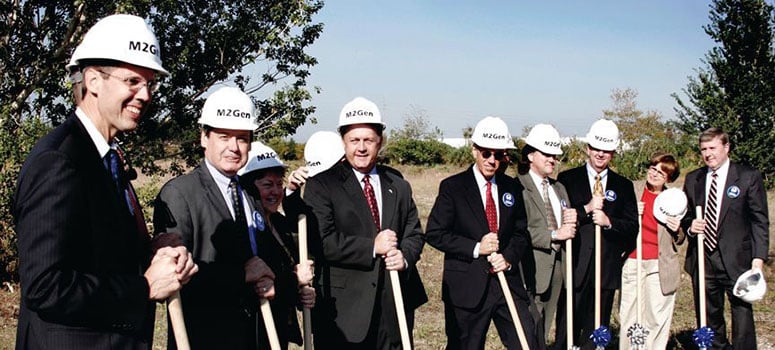
Moffitt leaders break ground on the new M2Gen building.
- 2006: Moffitt’s visionary research protocol, Total Cancer Care, is the first to collect information and samples from cancer patients and follow them for life as new studies develop. Today, the databank of more than 140,000 patients fuels research of new therapies.
- 2006: The first Miles for Moffitt is held. Since its inception, the annual event has raised $10 million to support lifesaving cancer research projects.

Runners line up at the starting gate at the 2018 Miles for Moffitt race.
- 2009: Moffitt opens the Faculty Office Building on the Magnolia Campus. It is home to a new radiation oncology center, clinical lab space and a 36-bed bone marrow transplant unit, and offers additional office space and parking.
- 2011: Moffitt at International Plaza opens.
- 2011: The Adolescent and Young Adult (AYA) Program is created to address the unique needs of cancer patients ages 15-39.
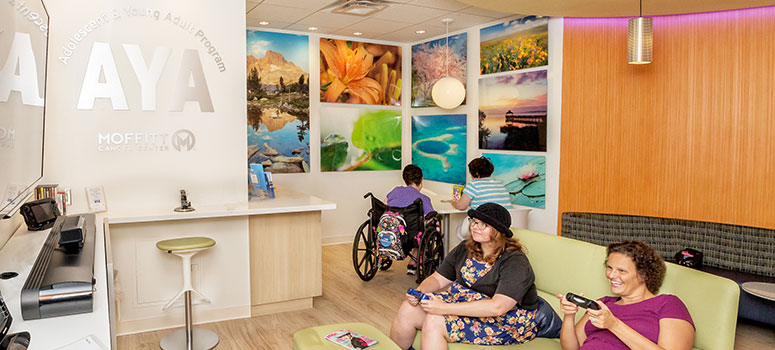
Young adult patients enjoy time in the AYA Lounge.
- 2014: Moffitt plays a groundbreaking role in the FDA approval of two new revolutionary melanoma treatments. Mekinist in combination with Tafinlar is approved for melanoma patients who express certain gene mutations, and Keytruda is approved for patients with advanced melanoma whose cancer has progressed on prior therapies.
- 2015: The American Nurses Credentialing Center awards Moffitt its prestigious Magnet recognition for nursing professionalism, teamwork, quality, patient care and innovation. Less than 10% of health care organizations nationwide achieve this designation.
- 2015: The McKinley Outpatient Center opens. The center is renamed the Richard M. Schulze Family Foundation Outpatient Center at McKinley Campus in 2019.
- 2017: Moffitt creates the George Edgecomb Society so donors can help create equitable health outcomes and eliminate cancer health disparities among Blacks and African Americans. Since then, this society has raised over $1.2 million in pledges and donations toward this cause.

Guests gather at the 35th Annual George Edgecomb Scholarship Banquet.
- 2017: The FDA approves the first CAR T therapy, a revolutionary immunotherapy for adult patients with diffuse large B cell lymphoma. Moffitt co-led the pivotal national trial, which spanned two years and included more than 101 patients.
- 2018: Recognizing the need to formalize, harmonize and expand the scope of our longstanding commitment to serve the community, Moffitt establishes the Office of Community Outreach, Engagement & Equity.
- 2019: Moffitt once again earns Magnet designation, which is considered the gold standard of excellence in nursing.
- 2019: Moffitt purchases 775 acres of land in Pasco County with the vision to create a massive research and corporate innovation district. Long term plans include more than 16 million square feet of research labs, light industrial and manufacturing, general office and clinical space. The multiyear, multiphase project will create an estimated 14,500 jobs.
- 2020: Moffitt team members overcome the unprecedented challenges presented by the global COVID-19 pandemic through teamwork, ingenuity and selfless dedication to the mission.
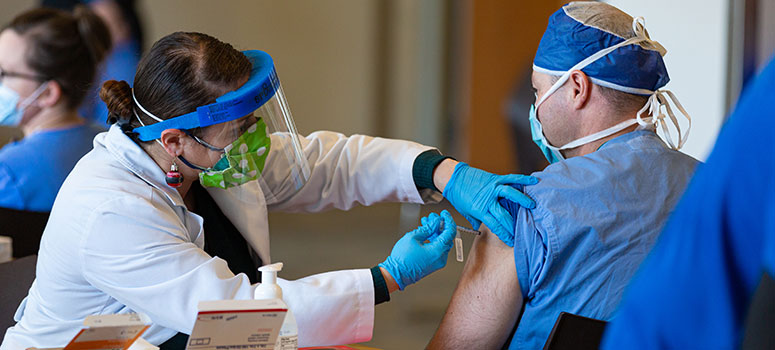
Team members were among the first to receive the COVID-19 vaccine when it became available.
- 2020: In response to the COVID-19 pandemic, a curbside clinic opens at the Richard M. Schulze Family Foundation Outpatient Center at McKinley Campus. The clinic offers select services to patients from inside their cars, such as injections, lab draws and port flushing.
- 2020: Moffitt breaks ground on a new 10-story, 498,000-square-foot inpatient surgical hospital located on 20 acres across from the Richard M. Schulze Family Foundation Outpatient Center. When completed in 2023, the new hospital will boast 128 inpatient beds with the capacity to expand to 400 beds as demand grows. It features 19 operating rooms large and flexible enough for current and future technologies, as well as 72 perioperative rooms.
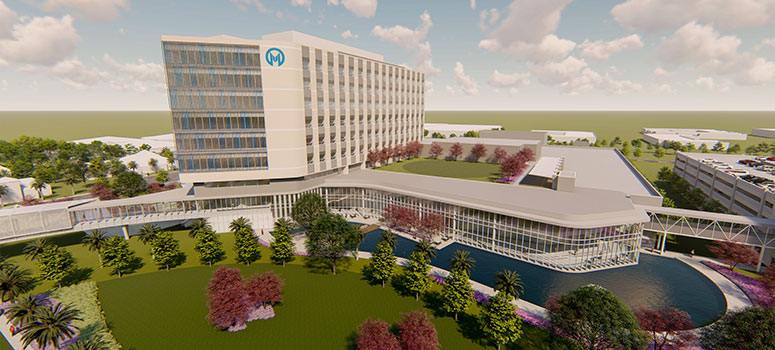
The expansion hospital will open in 2023.
- 2021: Moffitt at Wesley Chapel opens, bringing expert cancer care and research closer to home for patients who live north of Tampa.
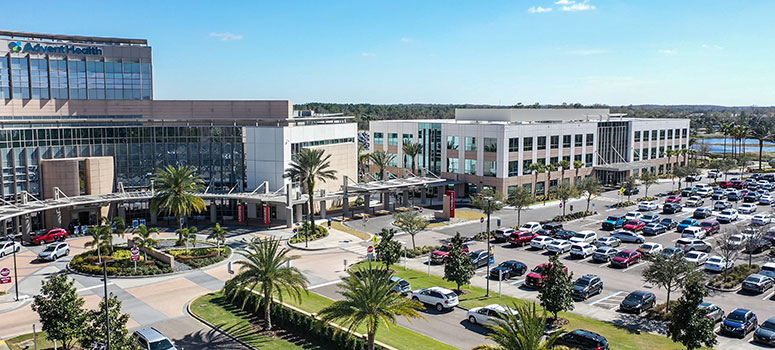
Moffitt Cancer Center at Wesley Chapel is a 28,000-square-foot outpatient facility bringing access to Moffitt expertise and nationally-ranked cancer care to Pasco County.
36. 2023: Moffitt breaks ground on the 775-acre SPEROS FL campus in Pasco County. The groundbreaking symbolized the beginning of construction of the complex, including a 100,000-square-foot clinic and a research center sprawling 250,000 square feet. A state-of-the-art proton flash therapy unit will open on the site in 2026.
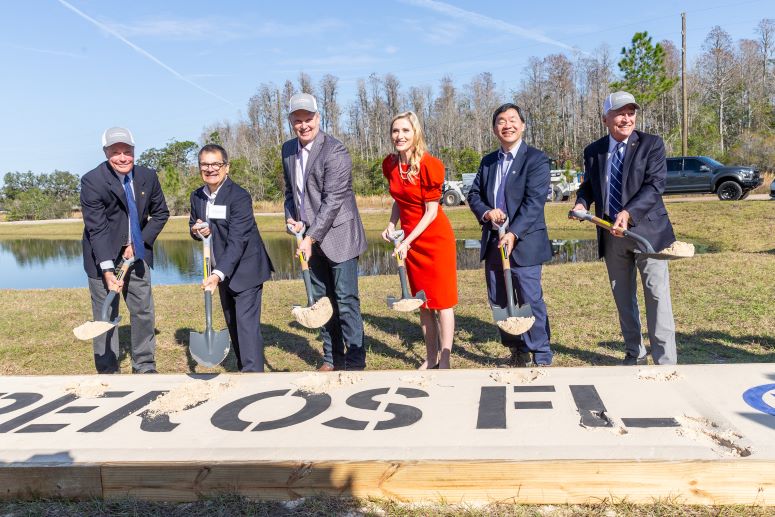
From left: Tim Adams, chair of Moffitt’s Institute Board; U.S. Rep. Gus Bilirakis; Wilton Simpson, Florida Commissioner of Agriculture; U.S. Rep. Laurel Lee; Dr. Patrick Hwu, Moffitt’s president and CEO; and founder H. Lee Moffitt make it official at the groundbreaking of Speros FL.
37. 2023: Moffitt celebrates the opening of the Moffitt McKinley Hospital. The state of the art inpatient surgical hospital is located on 20 acres across from the Richard M. Schulze Family Foundation Outpatient Center. It is a 10-story, 489,000-square-foot facility that features 19 operating suites, 128 inpatient rooms, 72 perioperative rooms, an intraoperative MRI, a diagnostic CT scanner and two nuclear medicine cameras. Opening with 80 inpatient beds, it has the capacity to expand to 400 to meet future demand.
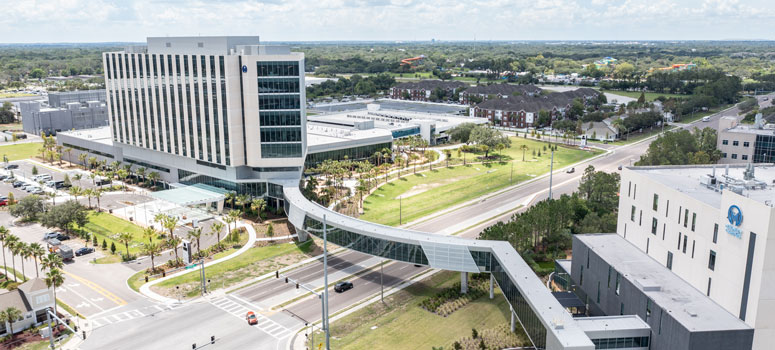
To determine the best amenities and shape the hospital around patient and family needs, Moffitt leveraged the expertise of its Patient and Family Advisory Council. Patient and family advisors assisted with the design of patient rooms, family waiting areas, a surgical discharge lounge, visitor showers and family laundry facilities.


